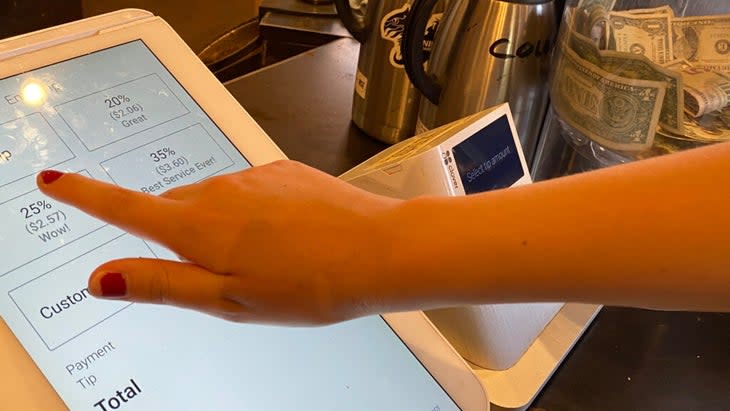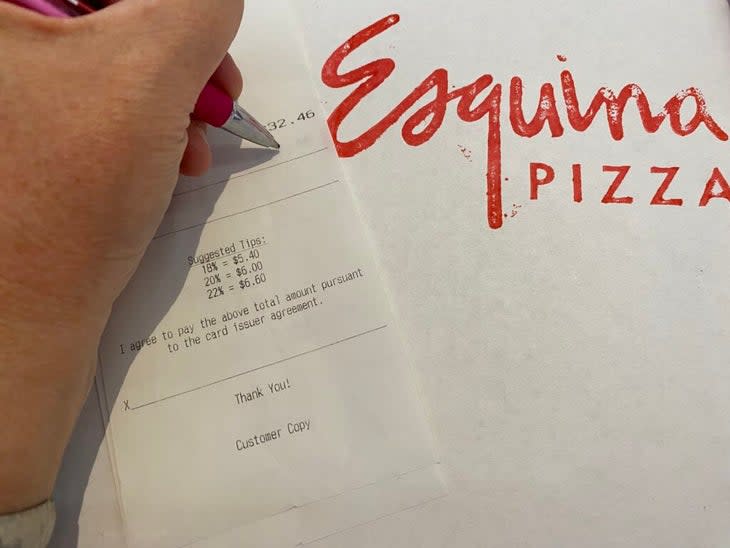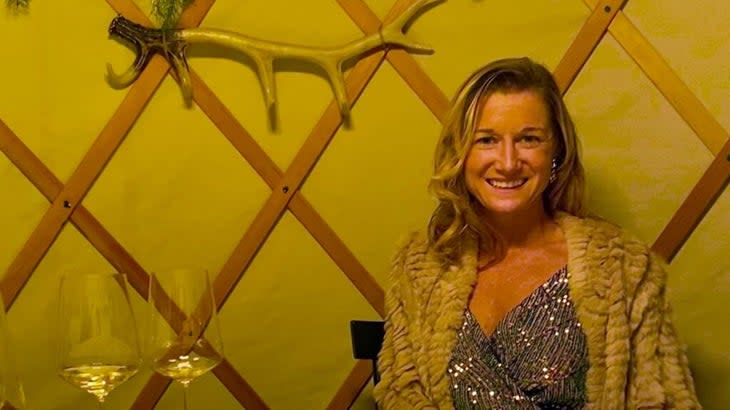Tipping Is Out of Control. Here Are the New Rules.
This article originally appeared on Outside
Any number of concerns are on our radar as we plan our next trip, from serious issues like how destinations are working to mitigate tourists' environmental impact to inconveniences like months-long passport wait times. In this column, our travel expert addresses your questions about how to navigate the world.
Tipping has gotten so out of control. I feel like post COVID, I'm expected to tip 30 percent, an amount I find ridiculous and frustrating. This happens most frequently at cafes and restaurants, but it also comes up with outdoor guides. What’s going on? Please don’t tell me this is the new norm. --Tipped Off
It gives me pleasure to reward an exceptional ski guide or attentive bartender with a generous tip. But when tipping is no longer my choice, I start to feel indignant.
These days, restaurants are including service fees with the bill, outdoor outfitters are automatically adding built-in tips, and at checkout kiosks, payment screens suggest we tip 25, or even 30, percent. I recently heard about someone being asked for a tip after helping a customer who was checking in at the airport. This profusion of requests for increased gratuity, particularly at places we're not used to seeing it, is called tipflation. And you're right, it's getting ridiculous.
Why Has Tipping Increased?

Blame it on the rise of point-of-sale technology. You've seen the screen prompts asking for a tip at the end of your transaction, in some cases upward of 30 percent. Business owners say the automated cues can significantly boost staff gratuities. But the latest point-of-sale software feels sneaky, showing suggested tips in dollars or percentages, calculating the tip before or after tax, and making the custom tip (or no tip) button hard to find.
More than half of Americans believe tipping screens are coercing them into paying more than they think is always deserved, according to a survey by Bankrate, a consumer financial services company. A 2017 Cornell University study found that larger suggested tips resulted in increased gratuity but not increased customer satisfaction, spending, or client retention. I often leave annoyed and not wanting to return when I'm asked for a tip at a place that doesn't feel appropriate.
But it's hard not to feel self-conscious when your barista (and anyone in line behind you) is watching you navigate the iPad tipping screen. Recently at my local coffee shop, I bypassed the digital gratuity and tossed a dollar in the tip jar instead. While I felt cheap, my $5 drip coffee certainly didn't warrant a $5 tip, as the screen suggested.
According to New York etiquette expert Thomas P. Farley, a.k.a. Mister Manners, my dollar was appropriately generous.
"Guilt tipping has reached epidemic levels with the mass adoption of tablets at point-of-purchase," he told me, noting that people are generally befuddled about modern-day tipping etiquette. Farley, who recently gave a Ted Talk called "The Tipping Invasion: How America Became the Country that Tips for Everything, Everywhere, All at Once," says that tipping for any point-of-purchase transaction, as opposed to sit-down service, should be at your discretion. "A general rule is that somebody behind a coffee shop counter or check-out screen is being paid minimum wage, so there should be no obligation to tip," he says.
When I mentioned that customers can feel responsible for improving wages perceived as low for hourly workers, he replied: "A customer is not expected to know--let alone assess--the wages or pay structure for employees at the establishments they frequent. For counter employees, the burden is squarely on the place of business to pay a fair and livable wage. Transferring that responsibility to customers is neither supported by tradition nor ethical."
But that doesn’t mean you shouldn't reward good service. In a coffee shop, for example, if your order involves more than scanning a barcode and entails some degree of skill and care (maybe creating latte art with your foam or remembering your go-to order), Farley believes it warrants a tip. How much you tip is up to you, he says, adding that you need not feel bound by amounts suggested on screens.
What's the Normal Tipping Rate These Days, and What's Included?
Tipflation has left us wondering just who to tip and how much. In our largely cash-free economy, it's more important than ever to make sure you have cash--particularly small bills--handy for tipping when you travel. We all know a dollar doesn't go as far as it once did. According to Farley, leaving a buck for a bellhop, housekeeper, or cocktail mixologist simply doesn't cut it in 2023. Fives are more thoughtful, says Farley.
"Tipping one dollar is more suited to an interaction with a high-volume, low-effort service professional, such as a washroom attendant who hands you a paper towel or a bartender who uncaps your beer," he says. Tens and twenties should be doled out to those delivering a more extensive service, like a tour guide, he says.
The restaurant industry is a sector unto itself. Hard-hit by COVID, many business owners have since tacked on an average of 3 percent in service fees to bills, claiming the extra charge goes toward employee wages and well-being. If you look at your itemized receipt, you'll see them listed as a kitchen appreciation or staff wellness fee or an inflation surcharge.
"These supplemental fees are a way that restaurant owners are attracting and retaining staff without increasing their own bottom lines," explains Farley. Alimento, a restaurant in Los Angeles, for example, adds 4 percent to bills to cover staff health insurance, plus a $1.50 tap-water donation. Last month its restaurateur defended his actions, telling Los Angeles Magazine that his surcharges were "hardly unique" in a city where "dozens if not hundreds" of establishments were doing the same thing.
"Guilt tipping has reached epidemic levels with the mass adoption of tablets at point-of-purchase," says Mister Manners.
Farley recently dined at a restaurant in Denver that levied a 20 percent fee to ensure staff receive a livable wage. "When the time came to pay the bill and the server hovered over me with a handheld point-of-purchase device, I was stunned to see a fresh option to tip on the total," he says. After inquiring, the server told Farley that the initial 20 percent fee was shared among all staff and the end-service fee was for his service in particular. Farley left the restaurant having paid 40 percent in service fees. "I would have preferred higher-priced menu items to these tacked-on charges," he says.
Even though tipping 40 percent seems outrageous, Farley says you should still leave 15 to 20 percent gratuity at a restaurant--even if other fees have been included--to guarantee your server is properly compensated (if they did indeed go above and beyond). Don't hesitate to question where any added charges actually go, and if you don't agree with the answer, he says, it's not bad manners to speak to a manager and ask if the fee can be waived.

How Much Should You Tip a Tour Guide or an Adventure Outfitter?
When it comes to the outdoor industry, tipping etiquette for guides is even more confusing. Many companies, like Mountain Travel Sobek, send out pre-trip emails clearly stating that it's customary to tip guides but that the amount is up to you. Others provide a suggested amount to tip per day.
Cycling Country Bike Tours, a small family-run company in Spain, sends clients pre-tour information stating that a 5 percent gratuity of the tour price is appreciated by guides. But, according to its director, Maggi Jones, it tends to go unnoticed.
"We have great reviews, the guests rave about the guides, but when it comes down to it, people walk away without giving any [monetary] thanks," she says. What's ironic is that people will commonly lay down a $20 restaurant tip for a server they spent three minutes with, and leave the same amount or nothing at all to someone who has guided them hundreds of miles cycling, made their picnics, and fixed their punctured tires. If you can dole out $5,000 for a weeklong cycling trip, and the service is great, you should tip the guide the company's recommended gratuity.
Most guides agree that when carrying cash was more common, so were tips. Digital transactions require an internet connection, which isn't always available in the wilderness. To make sure guides are compensated for their efforts, and to remove the guesswork that tends to happen at the end of a tour, some outfitters now build tips into the fee during the booking process.
When an Outside editor recently booked a bioluminescent kayaking tour online with Blue Waters Kayaking in Point Reyes Station, California, she noticed a 15 percent gratuity fee included for the guides. "I think I should be able to judge for myself what kind of tip I want to offer in the end, depending on how things go, not beforehand," she rationalized.
John Granatir and Pamalah MacNeily, the owners of Blue Waters Kayaking, note that the bioluminescence tours are their only public-enrollment tours to incorporate automatic gratuity to the total fee. Due to the nature of this popular tour, which happens at night under completely dark skies and is led by guides with wilderness-medicine training, more often than not, guests would express gratitude verbally at the end but then say they didn't have cash on hand. Guides weren't getting tipped at all.
The outfitter implemented auto-gratuity to the trip in the fall of 2020. The owners say many guests choose to tip additionally after the experience and only a handful have requested tip refunds, often due to weather, not service. They've obliged all refund requests.
At the end of the day, says Farley, tipping should be an option, not an obligation. You don't have to leave a tip just because you're asked to. If you choose to, it should be a reflection of your satisfaction with the service, not what someone else (or a screen) is suggesting.

Outside correspondent Jen Murphy is on the road nearly 80 percent of the year. As a teenager, she spent many summers waitressing in her hometown on the Jersey Shore and always tips 20 percent.
For exclusive access to all of our fitness, gear, adventure, and travel stories, plus discounts on trips, events, and gear, sign up for Outside+ today.

